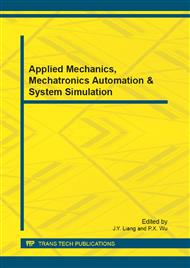[1]
R. Unger and J. Moult: A genetic algorithm for 3D protein folding simulations, " Proc. 5th Int. Conf. on Genetic Algorithms (1993), p.581– 588.
Google Scholar
[2]
G. Q. Zheng, in: Research on Modified Extremal Optimization Algorithms and Their Applications, Combinatorial Optimization Problems, Zhejiang University (2011).
Google Scholar
[3]
A. Shmygelska and H. Hoos, in: An ant colony optimisation algorithm for the 2D and 3D hydrophobic polar protein folding problem, BMC bioinformatics (2005), vol. 6, p.30.
Google Scholar
[4]
G. Zarand, et al., in: Using hysteresis for optimization, Physical review letters (2002), vol. 89, p.150201.
Google Scholar
[5]
J. Zha, G. Q. Zheng and Y. Z. Lu, in: Hysteretic Optimization for Protein Folding on the Lattice, Computational Intelligence and Software Engineering (2010), pp.1-4.
DOI: 10.1109/cise.2010.5676986
Google Scholar
[6]
C. B. Anfinsen, et al., in: The kinetics of formation of native ribonuclease during oxidation of the reduced polypeptide chain, Proceedings of the National Academy of Sciences of the United States of America (1961), vol. 47, p.1309.
DOI: 10.1073/pnas.47.9.1309
Google Scholar
[7]
K. A. Dill, in: Theory for the folding and stability of globular proteins, Biochemistry (1985), vol. 24, pp.1501-1509.
DOI: 10.1021/bi00327a032
Google Scholar
[8]
S. X. Li and Y. J. Zhang, in: Simulation of 3D Protein Folding with Improving Genetic Algorithms, Chinese Journal of Analytical Chemistry (2009), vol. 37, pp.57-61.
Google Scholar
[9]
B. Berger and T. Leighton, in: Protein folding in the hydrophobic-hydrophilic (HP) model is NP-complete, Journal of Computational Biology (1998), vol. 5, pp.27-40.
DOI: 10.1089/cmb.1998.5.27
Google Scholar
[10]
H. Lu and G. Yang, in: Extremal Optimization for protein folding simulations on the lattice, Computers & Mathematics with Applications (2009), vol. 57, pp.1855-1861.
DOI: 10.1016/j.camwa.2008.10.061
Google Scholar
[11]
D. Chu, M. Till, and A. Zomaya, in: Parallel ant colony optimization for 3D protein structure prediction using the HP lattice model, Parallel and Distributed Processing Symposium (2005), p. 193b.
DOI: 10.1109/ipdps.2005.326
Google Scholar
[12]
B. Gonçalves and S. Boettcher, in: Hysteretic optimization for spin glasses, Journal of statistical mechanics: theory and experiment (2008), vol. 2008, p. P01003.
DOI: 10.1088/1742-5468/2008/01/p01003
Google Scholar
[13]
W. Q. Huang and M. L. Cui, An Efficient PERM Method for Protein Folding Problem, Microcomputer Applications (2004), vol. 25, pp.268-273.
Google Scholar
[14]
K. F. Pál, in: Hysteretic optimization, faster and simpler, Physica A: Statistical Mechanics and its Applications (2006), vol. 360, pp.525-533.
DOI: 10.1016/j.physa.2005.05.040
Google Scholar
[15]
K. F. Pál, in: Hysteretic optimization for the traveling salesman problem, Physica A: Statistical Mechanics and its Applications (2003), vol. 329, pp.287-297.
DOI: 10.1016/s0378-4371(03)00597-1
Google Scholar
[16]
J. Zha, in: Study on Protein Folding Problem Based on the Hysteretic Optimization and Extremal Optimization, Zhejiang University (2011).
Google Scholar
[17]
M. T. Hoque, M. Chetty, and L. S. Dooley, in: A guided genetic algorithm for protein folding prediction using 3D hydrophobic-hydrophilic model, Evolutionary Computation (2006), pp.2339-2346.
DOI: 10.1109/cec.2006.1688597
Google Scholar


